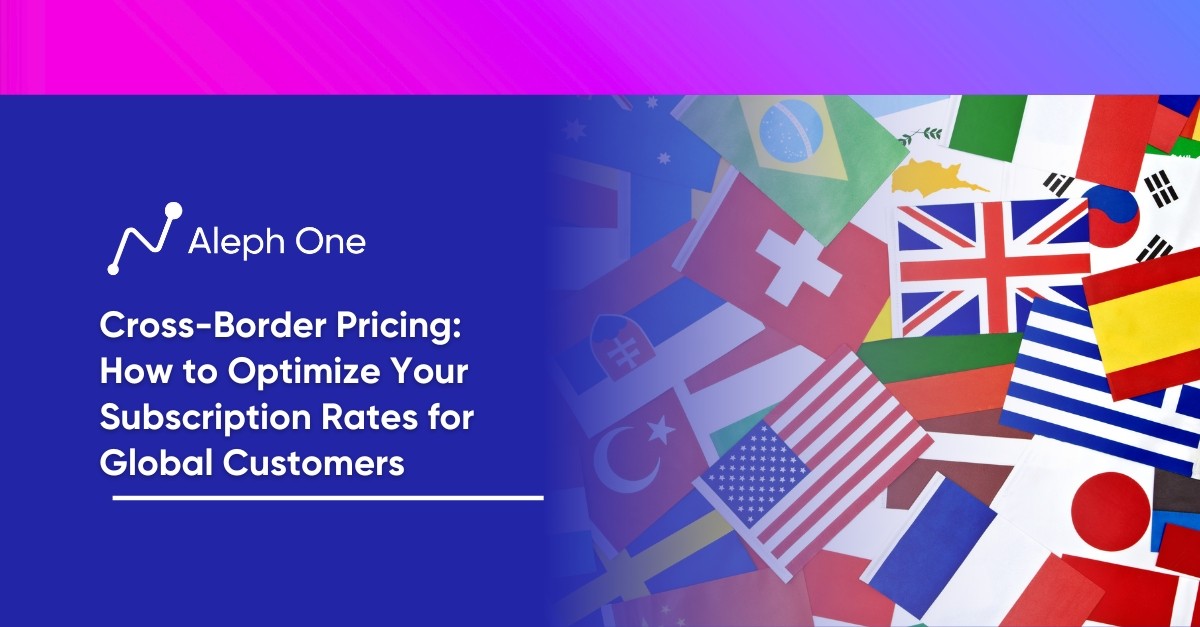Let’s work together to build something amazing. Share your project details and our team will reply to figure out the next steps to your success.

Cross-border pricing is a critical factor in the success of global expansion, as it enables companies to tap into new revenue streams and unlock profitable growth opportunities. However, navigating the complexities of setting prices for customers in different countries poses significant challenges. A one-size-fits-all approach can result in missed revenue or customer alienation, while a lack of coordination across borders can lead to channel conflicts and frustration. This article provides a comprehensive guide to cross-border pricing, including common challenges, winning strategies, transitioning between pricing models, critical success factors, and future trends. Startups can achieve higher profits, margins, and customer satisfaction on a global scale with informed cross-border pricing.

The Global Pricing Opportunity: Unlocking New Revenue Streams
Global expansion is a priority for companies of all sizes seeking new revenue and growth opportunities. As companies extend their reach into new international markets, they gain access to new customer segments willing to pay for their products and services. However, companies must optimize how they set customer prices across borders to capture the opportunity entirely.
A Key to Unlocking Revenue and Profitability
Cross-border pricing refers to companies’ strategies and processes to determine customer prices in different countries and regions. When done well, it can unlock substantial revenue and profitability.
The Pitfalls of a One-Size-Fits-All Approach
The opportunity is clear, but the path to achieving it is complex. Each country has unique dynamics, including economic factors, competitive forces, and customer preferences that shape how much customers are willing to pay. Companies that apply a one-size-fits-all approach to global pricing risk leaving money on the table or alienating new customer bases. At the same time, if prices are coordinated across borders, it can lead to channel conflicts and customer frustration.
Using Data-Driven Insights for Cross-Border Pricing
To capture the global pricing opportunity, companies need to develop a tailored strategy that balances these forces. The starting point is gaining a holistic view of current global pricing performance using metrics like price discrepancies between countries, the company’s global price positioning, and how much revenue and profitability are at stake if changes are made. With data-driven insights, companies can determine how to optimize their cross-border pricing to unlock new revenue streams while mitigating risks. The result is a win-win: higher profits and margins for the business and fair, compelling prices for customers wherever they are.
The global expansion opens up exciting new growth opportunities, but only for those able to conquer the complexities of cross-border pricing. By developing a tailored strategy and data-driven approach, companies can optimize their global pricing, tap into new revenue streams, and achieve profitable growth on an international scale.
Common Cross-Border Pricing Challenges: Navigating a Complex Maze
Companies expanding globally face several significant challenges in optimizing their cross-border pricing. A major issue is price discrepancies across countries, confusing customers and undermining a consistent brand experience. For example, a subscription that costs $50 in the U.S. may be priced at $30 in Mexico and $70 in Europe based on local market conditions. A coherent strategy makes these price differences seem reasonable and manageable for customers.
Channel Conflicts
Channel conflicts are also common, such as when a company sells through direct and reseller channels in the same region. If prices are not adequately coordinated across channels, it can lead to resentment from partners and loss of sales. Compliance risks further complicate matters, as pricing strategies must adhere to local regulations around price discrimination, competition, and other issues. Failure to comply can result in legal trouble and financial penalties.
Complex Tax Structures and Rules
Navigating local tax codes also poses challenges, especially for companies used to simpler tax structures in their home market. Taxes can significantly impact customers’ prices, so companies must factor them into their pricing strategies. However, tax rules vary in complexity between countries and change frequently, making them difficult to keep up with.
Ensuring Cohesion and Control
Companies must address these challenges to maintain control and visibility into how their pricing is set and perceived in critical markets. They may face backlash from customers and partners over illogical price differences, compliance failures, and other issues. Their global pricing strategy will need more cohesion, undermining their ability to optimize revenue and growth worldwide. The key is developing a comprehensive approach that accounts for these challenges through close coordination of pricing across borders, channels, and other variables based on a deep understanding of local market needs and regulations. By anticipating and mitigating risks, companies can pursue global expansion with confidence.
5 Winning Global Pricing Strategies: A Blueprint for Success
The optimal global pricing strategy depends on a company’s priorities and business model. Here are five of the most effective approaches:
- Localized Pricing: Setting different prices for each local market based on demand and competition. This maximizes revenue in each market but can be complex to manage and lead to price conflicts. Companies like Netflix and Spotify use localized pricing for subscriptions.
- Regional Pricing: Grouping markets with similar profiles into regions and setting a single price for each region. This balances customization and complexity. Many software companies use regional pricing for SaaS products.
- Cost-Plus Pricing: Adding a consistent markup percentage to costs in each market. This is simple but often leaves money on the table, resulting in prices that seem arbitrary to customers. Most manufacturing companies use cost-plus pricing for international distribution.
- Value-Based Pricing: Setting a single global price based on the overall value to the customer, regardless of local costs or competition. This reinforces a premium brand positioning but requires high customer loyalty and willingness to pay. Luxury brands frequently use value-based pricing.
- Dynamic Pricing: Using algorithms to frequently adjust prices in each market based on local demand, competition, and other factors. This optimizes revenue but can be challenging to implement and may need to be more transparent and clear to customers if appropriately managed. A few e-commerce and travel companies use dynamic pricing for global offerings.
The optimal approach is often a hybrid model that combines multiple strategies. For example, a company may use localized pricing for its core offering, value-based pricing for a premium product line, and cost-plus pricing for an entry-level line. With a strategic, multi-tiered global pricing system, companies can overcome complexity and unlock substantial revenue opportunities.
How to Transition Between Strategies: A Step-by-Step Guide
Transitioning from one global pricing strategy to another requires careful planning and execution. Companies should follow these steps:
1. Determine the Optimal New Strategy
Analyze how your business objectives and priorities have changed to identify the best approach going forward. For example, if expansion into new markets is now a higher priority, a market penetration strategy may be better suited than a premium pricing strategy.
2. Develop a Detailed Implementation Plan
Develop a detailed implementation plan. This includes determining specific price points for each market, communicating the changes to internal teams and partners, and planning any system or process updates required. Address any potential channel conflicts or compliance issues. Set a timeline for rolling out the new strategy in phases.
3. Communicate Changes to Customers
For price increases, notify customers in advance and explain the reasons for the changes. Be available to address concerns. For price decreases, the announcement generates excitement. Offer incentives for customers to lock in lower prices.
4. Provide Internal Training
Educate sales, marketing, and customer service teams on the new pricing strategy. Ensure they can clearly articulate the rationale and benefits to customers. Provide opportunities for teams to give input on any challenges with the new approach.
5. Monitor the Transition Closely
Track how the new strategy impacts critical metrics like customer churn, acquisition, and revenue growth. Look for any unexpected issues arising and make adjustments quickly. Be prepared to slow down or roll back the transition if needed.
6. Continue Optimizing Over Time
Review pricing against the new strategy regularly. Make refinements to account for changes in the market, competitive landscape, or customer base. Transitions are a continuous process, not a one-time event.
With proper planning and management, companies can successfully transition between global pricing strategies to drive growth and better serve customers worldwide. The key is taking a phased, customer-centric approach while monitoring progress and adapting as needed. With time and practice, transitions become easier to navigate.
Key Success Factors: A Checklist for Getting it Right
For companies pursuing cross-border pricing strategies, several key factors determine whether their efforts will pay off:
Align Pricing with Brand Positioning
Your pricing strategy should match your brand positioning and value proposition in each market. If you position yourself as a premium brand, your prices should reflect that. If you compete on affordability, your prices need to be lower. Pricing misaligned with your brand can confuse customers and hurt conversion rates.
Monitor the Competitive Landscape
You need to set prices that reflect the competitive dynamics in each market. That means regularly analyzing competitors’ pricing, promotions, and new product introductions. You may need to adjust your pricing to match or beat competitors and avoid losing customers. But don’t engage in a race to the bottom.
Optimize Prices Locally
Global companies often make the mistake of setting a single price across all markets. But customer needs, costs of living, and willingness to pay differ in each country. Work with local teams to determine optimal price points based on local market conditions. Localized pricing will result in higher customer satisfaction and conversion.
Simplify the Customer Experience
A complex web of different prices, payment methods, and checkout experiences across markets will only confuse customers and hurt your business. Aim to simplify the purchasing experience for your global customers as much as possible. Provide pricing transparency and consistent payment options across borders.
Review and Revise Regularly
Conduct regular reviews of your cross-border pricing strategy and make revisions as needed to account for changes in the market, competitive landscape, costs, and customer needs. Pricing should not be static. Build processes to monitor critical metrics like conversion rates, customer satisfaction, and revenue to determine when prices need adjustment.
With the right approach to cross-border pricing, companies can unlock substantial revenue opportunities on a global scale. However, success depends on following best practices, avoiding common mistakes, and building a strategic pricing framework tailored to customers’ needs in each market. By getting these key factors right, businesses can overcome challenges and compete more effectively globally.
The Future of Global Pricing: Trends to Watch
Emerging trends are shaping the future of global pricing. Companies must monitor these trends closely and determine how they will impact their cross-border pricing strategies.
Hyper-Personalized Pricing
As companies access more customer data and advanced analytics, hyper-personalized pricing will become more common. Customers may be offered different prices for the same product based on their willingness to pay. This could enable companies to maximize revenue from global customers. However, it requires sophisticated capabilities and risks negatively impacting customer experience if not implemented properly.
Product Bundling for Global Customers
Companies may start bundling localized products and services together for global customers. For example, a media company may bundle a subscription to its domestic streaming service with access to its content library in international markets. This provides added value to global customers but requires navigating increased complexity. Pricing and bundling must be optimized for different customer segments in each market.
Advancing Pricing Technology
Technologies like artificial intelligence, machine learning, and virtual reality will transform global pricing capabilities. AI and machine learning can help automate personalized pricing and optimize it worldwide. Virtual reality may allow customers to experience products in different markets before purchasing. Companies must invest in these technologies to remain competitive but implement them gradually to manage risks.
Future-proof Global Pricing
To future-proof their global pricing, companies must build the capabilities to leverage these trends and remain flexible. They must take an innovative and customer-centric approach to developing global pricing strategies. With the right mindset and abilities, these emerging trends can provide opportunities to unlock new revenue streams from international expansion. But with proper planning and execution, companies can keep up with the pace of change. By evaluating how these trends may impact their business, companies can ensure their global pricing strategies are ready for the future.
How can companies effectively balance localized and global pricing strategies for optimal revenue and customer satisfaction?
Companies can effectively balance localized and global pricing strategies by developing a hybrid model that combines multiple approaches. For example, they can use localized pricing for their core offering and value-based pricing for a premium product line. Ensuring close coordination between local market teams, regularly reviewing and adjusting prices based on market changes, and providing customer transparency can help maintain optimal revenue and customer satisfaction.
What are the most common pitfalls in implementing a cross-border pricing strategy and how can they be avoided?
Common pitfalls in implementing a cross-border pricing strategy include failing to recognize local market dynamics and customer preferences, lack of coordination and communication between channels, and overlooking regulatory compliance. To avoid these issues, companies should develop a comprehensive strategy based on a deep understanding of local market needs, regularly review and adjust pricing, and collaborate closely with local teams and partners to ensure compliance with local regulations.
How can businesses leverage emerging trends like hyper-personalized pricing and advanced pricing technology to future-proof their global pricing strategies?
Businesses can leverage emerging trends like hyper-personalized and advanced pricing technology by investing in data analytics, AI, and machine learning capabilities. These technologies can help automate personalized pricing and optimize it globally. Companies should also continually monitor and evaluate the potential impact of these trends on their business and be prepared to adapt their strategies accordingly to remain competitive and future-proof their global pricing.
Get the latest news and updates from Aleph One in your inbox.



